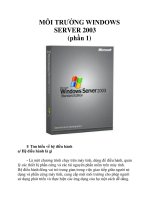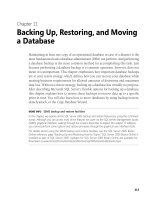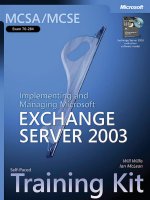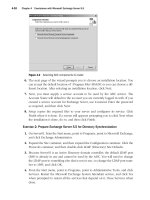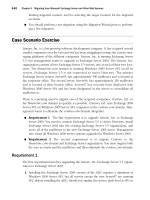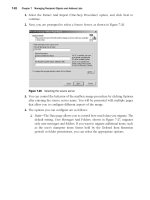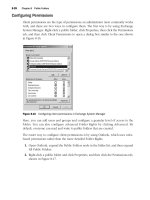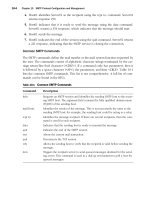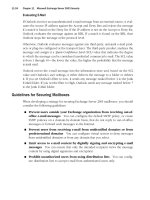Microsoft Press 70 284 training kit exchange server 2003 phần 6 ppsx
Bạn đang xem bản rút gọn của tài liệu. Xem và tải ngay bản đầy đủ của tài liệu tại đây (547.01 KB, 82 trang )
8-28 Chapter 8 Public Folders
Configuring Permissions
Client permissions are the type of permissions an administrator most commonly works
with, and there are two ways to configure them. The first way is by using Exchange
System Manager. Right-click a public folder, click Properties, then click the Permissions
tab, and then click Client Permissions to open a dialog box similar to the one shown
in Figure 8-16.
F08es16
Figure 8-16 Configuring client permissions in Exchange System Manager
Here, you can add users and groups and configure a granular level of access to the
folder. You can also configure advanced Folder Rights by clicking Advanced. By
default, everyone can read and write to public folders that are created.
The easier way to configure client permissions is by using Outlook, which uses roles-
based permissions rather than the more detailed Folder Rights.
1. Open Outlook, expand the Public Folders node in the folder list, and then expand
All Public Folders.
2. Right-click a public folder and click Properties, and then click the Permissions tab,
shown in Figure 8-17.
Lesson 3 Public Folder Security 8-29
F08es17
Figure 8-17 Configuring client permissions in Outlook
3. By default, everyone has the Author permission level, which gives them the right
to read and create items and to edit and delete their own items.
Tip The Permissions tab is available only to users and groups that have been configured
with the Folder Owner permission role. Non-owners cannot manipulate permissions.
4. To add users and groups, click Add and then assign each the desired role.
Exam Tip Because Outlook can see only public folders in the Default public folder tree, it
cannot be used to configure permissions for public folders that reside in General Purpose
trees. You will have to use Exchange System Manager to configure those permissions.
More client security settings can be configured by clicking the Administration tab,
shown in Figure 8-18, in the public folder’s properties.
!
8-30 Chapter 8 Public Folders
F08es18
Figure 8-18 Configuring additional security settings
The settings on this tab that are related to security are This Folder Is Available To and
Moderated Folder. You can choose whether all users with access permission can use
the folder (the default) or whether only users and groups assigned the Folder Owner
role can use the folder. A moderated folder is one that requires a moderator to approve
all messages that get posted to the folder. This is often used in customer mailing lists
or forums where it is highly desirable to limit the amount of off-topic traffic that gets
posted. When you click Moderated Folder, the Moderated Folder dialog box, shown in
Figure 8-19, opens.
To configure a moderated folder, you must first select the check box to make the folder
a moderated folder. Next, you need to assign a user or group to which new messages
to the folder should be forwarded. These users will view a message for content and
decide if it should be posted. Finally, you assign moderators that have the authority to
move the messages into the folder upon approval. You can also have an automatically
generated e-mail sent in reply to new messages to explain to the sender that the folder
is moderated and that they will not see their post until it is approved. You can use a
standard response or create your own custom response.
Lesson 3 Public Folder Security 8-31
F08es19
Figure 8-19 Configuring moderated folder settings
Configuring Directory Rights
Directory rights control what users and groups have permission to change e-mail-
related attributes of a mail-enabled public folder. By default, only the Administrator
account and members of the Administrators, Enterprise Admins, Exchange Domain
Servers, and Exchange Enterprise Servers groups have these permissions.
Authenticated Users are able to read permissions but not to do anything else. Gener-
ally, these settings are sufficient and don’t need to be changed. To change the directory
rights, perform the following steps:
1. Right-click the public folder in Exchange System Manager and click Properties.
2. Click the Permissions tab, and then click Directory Rights.
3. Add users or groups as desired and configure the permissions you want them
to have.
4. Click OK when you are done, and then click OK again to finish.
Configuring Administrative Rights
Administrative rights control the users and groups that can use Exchange System
Manager, a custom Microsoft Management Console (MMC) console, or any other
administrative utility to change the replication, storage limits, and other settings for a
public folder. By default, only administrators in the Active Directory domain and enter-
prise have administrative rights to a public folder.
8-32 Chapter 8 Public Folders
Configuring administrative rights is similar to configuring directory rights. Both are con-
figured on the Permissions page of a public folder’s properties.
Practice: Public Folder Security
In this practice, you will use Outlook to assign permission roles to a public folder to
two Active Directory user accounts. Then, you will configure the folder as a moderated
folder and assign a forwarding address and moderators to the folder.
Before you begin, create user accounts for the following users:
■ Jenny Lysaker
■ Bob Gage
■ Chris Meyer
Also, create the following public folders in the Default public folder tree:
■ Feedback
■ Support
Exercise 1: Assign Client Permission Roles
1. Open Outlook and expand the Folders container, and then expand All Public
Folders.
2. Right-click the Feedback public folder, and then click Properties. Click the Permis-
sions tab.
3. Click Add, and then add Jenny Lysaker, Bob Gage, and Chris Meyer. Assign Jenny
the Folder Owner permission, assign Bob the Publishing Editor role, and assign
Chris the Editor role. Note the differences in permissions each role has.
4. Click OK to finish.
Exercise 2: Configure a Moderated Public Folder
1. Right-click the Support public folder, and then click Properties. Click the Admin-
istration tab.
2. Click Moderated Folder.
3. Select the check box to Set Folder Up As A Moderated Folder.
4. Assign Jenny Lysaker to Forward New Replies To.
5. Add Jenny Lysaker and Bob Gage as moderators to the folder.
6. Click OK to finish.
Lesson 3 Public Folder Security 8-33
Lesson Review
The following questions are intended to reinforce key information presented in this
lesson. If you are unable to answer a question, review the lesson materials and then try
the question again. You can find answers to the questions in the “Questions and
Answers” section at the end of this chapter.
1. You are the senior Exchange Server administrator for Litware, Inc. You receive a
call from the customer support manager, who is concerned because customers are
calling to say that their e-mail messages sent to are being
returned as undeliverable. That address is associated with a public folder, so you
check the folder properties and find that the e-mail address has been changed
to After investigating, you determine that the
address was changed by your junior administrator, who normally is responsible
only for setting up e-mail addresses for new users. How would you restrict him
from being able to edit public folder e-mail addresses in the future?
2. You are the Exchange Server administrator for Contoso, Inc. The company has a
CustomerSupport public folder that functions as a discussion forum. The folder
resides in the Default public folder tree. The customer service manager, Bob, says
he needs to have administrator permissions to the folder in order to configure set-
tings such as limits, as needed, and to assign permissions to other support techs.
However, you have concerns about giving a non-administrator administrator
access. What permissions should you give Bob to ensure that he can do his job,
but not give him too much authority?
3. You are the senior Exchange Server administrator for Litware, Inc., a software
development company that sells a number of productivity applications. You have
a General Purpose public folder tree for your Customer Support forums. There is
a top-level folder called Support, which contains child folders named for each
product your company sells. Those folders contain child folders for different ver-
sions of each product. Support personnel regularly interact in these folders with
customers who post questions. Because each support tech works only on a par-
ticular product, each one is given permission to access only the parent folder and
child folders of the product he or she supports. You have a junior administrator
who configures the permissions to the folders for the support staff as required.
8-34 Chapter 8 Public Folders
One afternoon, you receive a call from the department manager, who states that
none of his support staff can access any of the public forums. You ask your junior
administrator, and he tells you he made a permission change on the top-level
folder but nowhere else. What did he do that is causing this problem?
Lesson Summary
■ Client permissions can be configured through Exchange System Manager for any
public folder and through Outlook for public folders that are in the Default public
folder tree.
■ Directory rights control the permissions to configure e-mail-related properties for
mail-enabled public folders.
■ Administrative rights control the permissions to run administrative utilities, such as
Exchange System Manager, to configure public folder settings such as limits and
replication.
Case Scenario Exercise
You are the Exchange Server administrator for Litware, Inc., a software development
company that specializes in productivity software. Litware employs approximately 500
people worldwide and has an extensive network of clients and resellers. The Exchange
organization consists of five Exchange Server 2003 computers located in different rout-
ing groups for sites throughout the world. The company is growing rapidly, and an
aspect of the growing pains has been that communication between internal sales and
support, and clients and resellers, has deteriorated. E-mail is not as effective as it once
was because often there is a need for multiple people to be involved in a project or sit-
uation, with each communicating with a group of people. As a result, tracking progress
is difficult.
You believe a public folder infrastructure would be better suited for the type of com-
munication that needs to take place, and you propose such a solution to management.
They agree that public folders have the potential to solve many of the problems, but
they have some requirements that they feel must be met before you can proceed.
■ Requirement 1 Management wants to ensure that the public folders for the cli-
ents do not get mixed up with the folders used internally. Ideally, they don’t want
internal users even to be able to see the client public folders.
Chapter 8 Public Folders 8-35
■ Requirement 2 Marketing is concerned about negative press and feedback, so
it wants posts to the Customer Support forum to be screened by a support
manager prior to being posted. They also do not want the Announcements folder
to be cluttered with irrelevant messages; it should have only announcements
posted to it.
■ Requirement 3 Accounting wants public folders set up for each client so they
can post a client’s account information, such as their aging reports. It is important
that this information always be available, even if one of the Exchange Server 2003
servers goes offline.
Requirement 1
The first requirement involves ensuring that client public folders do not get mixed up
with the company’s internal folders.
1. What is the ideal way to configure the client public folders so they will not be con-
fused with Litware’s internal folders?
a. Hide the public folders from the address lists.
b. Use a unique identifier as part of the name for each client folder so they are
easily identifiable.
c. Configure a separate public folder tree for the client folders.
d. Configure a separate public store for the client folders.
2. Explain why the correct answer to question 1 is the best choice.
3. Which of the following software programs would be able to access the client fold-
ers? Select all that apply.
a. Outlook Express
b. OWA
c. Outlook
d. Internet Explorer
8-36 Chapter 8 Public Folders
Requirement 2
The second requirement involves limiting who can post messages in certain public
folders.
1. The Marketing department wants to ensure that the Announcements folder does
not get cluttered with off-topic posts. What is the best way to configure this public
folder?
2. What is the best way to configure the Customer Support public folder?
Requirement 3
For this requirement, the Accounting department wants to be able to post confidential
customer account information and ensure that the data will always be available.
1. Because the Accounting department wants to post confidential information for
clients to see in public folders, what will you recommend for the solution?
2. Accounting decides to use a public folder to post nonconfidential client files, and
they need to ensure that the data is always available. How will you accomplish
this?
Troubleshooting Lab
In this lab, you will mail-enable a public folder and attempt to send an e-mail message
to it. When it fails, you will correct the problem by configuring an e-mail address for
the folder and then verifying it works.
Before proceeding with this lab, you must have met the requirements that were out-
lined at the beginning of the chapter, and you must have mailbox-enabled the
Administrator account. Outlook must be installed and configured with a mail profile for
the Administrator account.
Chapter 8 Public Folders 8-37
Exercise 1: Create a Public Folder and Test E-Mail
1. Open Exchange System Manager and navigate to the Folders container. Expand
the Folders container.
2. Expand Public Folders. Create a public folder called Feedback in the Default pub-
lic folder tree.
3. Minimize Exchange System Manager and open Outlook. Send an e-mail message
to the public folder
4. You will get a non-delivery report (NDR) almost immediately. Minimize Outlook
when you do.
Exercise 2: Mail-Enable and Create an Additional E-Mail Address for a
Public Folder
1. Maximize Exchange System Manager. Right-click the Feedback folder, point to All
Tasks, and then click Mail Enable.
2. Wait a couple of minutes, then right-click the Feedback folder and click Properties.
3. Click the E-Mail Address tab, and then click New. Click SMTP Address, and then
click OK.
4. Type for the address. Click OK, and then
click OK again to finish (leaving as the primary address).
Minimize Exchange System Manager.
5. Maximize Outlook. Send another e-mail to You should not
get an NDR this time.
6. Send a second e-mail to
7. Verify that the messages arrived in the public folder by navigating to the Feedback
public folder in the All Public Folders container in the Folder List. There should be
two unread messages in the folder—the ones you just sent.
Chapter Summary
■ Public folders must be mail-enabled before they can receive e-mail.
■ Public folders can be moved or copied within a public folder tree but not outside
of the tree.
■ Only the Default public folder tree is available to Outlook users.
■ General Purpose public folder trees can be accessed by NNTP and HTTP clients
but not by MAPI (Outlook and OWA) clients.
8-38 Chapter 8 Public Folders
■ Client permissions for public folders can be configured in Exchange System Man-
ager, or in Outlook for folders that are in the Default public folder tree.
■ Permissions in Exchange System Manager are rights-based, whereas permissions
configured in Outlook are roles-based (though they accomplish the same thing).
■ A public folder store must be associated with a public folder tree. An unassociated
public folder tree cannot be used, even though you can create public folders in it.
Exam Highlights
Before taking the exam, review the key points and terms that are presented in this
chapter. Return to the lessons for additional practice.
Key Points
■ General Purpose public folder trees are not available to MAPI (Outlook and OWA)
clients.
■ Public folder replicas are all equal. There is no “master replica.” Replication works
on a multimaster model like Active Directory.
■ Public folders cannot be moved or copied between public folder trees under any
circumstances.
■ Public store policies can be used to configure settings for storage limits and repli-
cation settings and can be used to apply one set of settings to as many public
stores as you assign the policy to. Each public store receiving the policy will by
default pass those settings on to all public folders in the store.
Key Terms
replica A copy of a public folder that is placed in a public store on another server.
Replicas are used to provide fault tolerance, allowing public folders to remain
available even if one server goes offline. Replicas are also used to help control
bandwidth usage by creating local copies of folders that otherwise would reside
on a remote server.
referral When a user attempts to access a public folder on a public folder server and
the server does not contain the content the user is looking for, a referral is made
to another public folder server. Referral servers are configured by default to use
routing group membership, but an administrator can also configure a custom
referral list to be used.
Questions and Answers 8-39
top-level folder In an Exchange Server 2003 public folder hierarchy, a top-level folder
is the highest level folder in the tree. By default, users can create top-level folders,
but a common security practice is to remove this permission so that only adminis-
trators can create top-level folders and users can create subfolders.
public folder tree A public folder tree is a container that creates a hierarchy of pub-
lic folders. Exchange Server 2003 supports two types of public folder trees: the
Default public folder tree and General Purpose public folder trees. You can have
only a single Default public folder tree in an organization, but you can have as
many General Purpose trees as necessary.
8-40 Chapter 8 Public Folders
Questions and Answers
Page
8-11
Lesson 1 Review
1. You are the Exchange Server administrator for Litware, Inc. You create a new pub-
lic folder tree to support customer forums, and you explain to users that they will
not be able to use Outlook to access these folders but will have to use Internet
Explorer instead. A couple of days later, you receive a call from a user who says
that they are using Internet Explorer, but they see only the same folders they see
in Outlook. They don’t see the customer forums. What are they doing wrong?
The user misunderstood what you meant when you said to access the customer forums using
Internet Explorer. The user has logged in through OWA, which is still treated like a MAPI client
and unable to see anything but the Default public folder tree. The user must use the specific
URL that goes to the customer forums folder tree.
2. You are the network administrator for Fabrikam, Inc., which has approximately
1,500 employees worldwide. You have delegated the task of creating public fold-
ers to your junior administrator and have restricted the ability for users to create
public folders. The sales director puts in a work order to have a number of public
folders created. Most of the folders will contain calendar and task items. Your
junior administrator tells you that he is having trouble completing the task and that
when he creates a public folder, there is no option for defining the item type.
What do you tell him?
He needs to use Outlook to create the public folders rather than Exchange System Manager.
When you create a folder in Exchange System Manager, it always defaults to holding Mail And
Post Items, and this cannot be changed. When you create a public folder in Outlook, you have
the option of defining the item type for the folder.
3. You create a new public folder tree for the purpose of setting up customer support
public folders but find that after creating the tree, you are unable to create public
folders in the tree. When you right-click the public folder tree and point to New,
the option for Public Folder is unavailable. Why?
Before you can create public folders in a public folder tree, you must first associate the tree
with a public store. The public store is where the public folder is held, so until you create the
store and associate it with the tree, you will be unable to create public folders in that tree.
Page
8-24
Lesson 2 Review
1. You are the Exchange administrator for Litware, Inc. The VP of marketing has
requested that an e-mail folder be set up for customer feedback. He wants a
way to monitor the messages that are coming in, and he wants new messages
to be forwarded to everyone in the marketing department except for himself. He
wants two designated people to be able to reply to messages using the
Questions and Answers 8-41
address. Would a distribution group or a public folder
be the best choice for this situation, and why?
You would need to use a public folder in order to meet the requirements of this scenario. By
using a public folder, the messages would be contained in a single location so the VP could
view the folder at his leisure to monitor feedback. This would keep the messages separate
from his personal e-mail, which is what he wants. In addition, you can configure a forwarding
address on the public folder to forward to designated marketing personnel. You could also
assign Send On Behalf permissions to the folder to the users that need to be able to reply to
customers using the feedback address.
2. You are the Exchange administrator for Contoso, Ltd., a company that has recently
merged with Fabrikam, Inc. Management wants to move several customer support
forums from Fabrikam into Contoso. The forums are public folders that exist in
different public folder trees on different servers. The two Exchange organizations
have already been merged, with the structure being that Fabrikam and Contoso
are in separate administrative groups. How would you move the folders?
a. Drag and drop the folders in Exchange System Manager from the current pub-
lic folder tree to the destination tree.
b. Cut the public folders from the current public folder tree and paste them into
the destination tree.
c. Create a replica of the desired folders in the destination tree, and delete the
original folders after the contents have replicated.
d. Create new public folders in the destination tree. Back up the folders in the
Fabrikam public folder tree and restore the contents to the folders in the
Contoso public folder tree.
The correct answer is d.
3. You attempt to configure storage limits on a public folder that needs to have a
greater limit than it currently has, but you find that all of the limit properties are
unavailable when you attempt to edit the properties of the folder. Why is this
happening?
There is a public store policy applied to the public store to which the public folder belongs.
When a policy applies, you cannot override it manually.
Page
8-33
Lesson 3 Review
1. You are the senior Exchange Server administrator for Litware, Inc. You receive a
call from the customer support manager, who is concerned because customers are
calling to say that their e-mail messages sent to are being
returned as undeliverable. That address is associated with a public folder, so you
check the folder properties and find that the e-mail address has been changed
to After investigating, you determine that the
address was changed by your junior administrator, who normally is responsible
8-42 Chapter 8 Public Folders
only for setting up e-mail addresses for new users. How would you restrict him
from being able to edit public folder e-mail addresses in the future?
By configuring the directory rights on the public folders, you can limit who is able to edit e-mail
properties for a public folder. This would allow you to ensure that the junior administrator would
not edit the e-mail address again.
2. You are the Exchange Server administrator for Contoso, Inc. The company has a
CustomerSupport public folder that functions as a discussion forum. The folder
resides in the Default public folder tree. The customer service manager, Bob, says
he needs to have administrator permissions to the folder in order to configure set-
tings such as limits, as needed, and to assign permissions to other support techs.
However, you have concerns about giving a non-administrator administrator
access. What permissions should you give Bob to ensure that he can do his job,
but not give him too much authority?
Because Bob needs to be able to configure administrative settings such as limits, you will need
to give him administrative rights to the CustomerSupport public folder. It would make sense to
also give him Folder Owner client permissions, but that permission by itself will not allow Bob
to administer settings for the folder. Administrative rights are assigned on a per-folder basis, so
the folder being in the Default public folder tree will not affect the situation.
3. You are the senior Exchange Server administrator for Litware, Inc., a software
development company that sells a number of productivity applications. You have
a General Purpose public folder tree for your Customer Support forums. There is
a top-level folder called Support, which contains child folders named for each
product your company sells. Those folders contain child folders for different ver-
sions of each product. Support personnel regularly interact in these folders with
customers who post questions. Because each support tech works only on a par-
ticular product, each one is given permission to access only the parent folder and
child folders of the product he or she supports. You have a junior administrator
who configures the permissions to the folders for the support staff as required.
One afternoon, you receive a call from the department manager, who states that
none of his support staff can access any of the public forums. You ask your junior
administrator, and he tells you he made a permission change on the top-level
folder but nowhere else. What did he do that is causing this problem?
The junior administrator propagated the changes. When you choose to propagate changes, the
permissions you configure on a parent folder will overwrite the permissions on a child folder.
The propagation is not cumulative, meaning the permissions do not add to what is already
there. Instead, the parent permissions replace the child permissions. As a result, the support
techs, who did not have permissions to the top-level folder, are now unable to access their own
folders.
Questions and Answers 8-43
Page
8-35
Case Scenario Exercise: Requirement 1
1. What is the ideal way to configure the client public folders so they will not be con-
fused with Litware’s internal folders?
a. Hide the public folders from the address lists.
b. Use a unique identifier as part of the name for each client folder so they are
easily identifiable.
c. Configure a separate public folder tree for the client folders.
d. Configure a separate public store for the client folders.
The correct answer is c.
2. Explain why the correct answer to question 1 is the best choice.
Configuring a separate public folder tree for the client folders will prevent Outlook users from
seeing the folders since only folders in the Default public folder tree are available to Outlook
users. This immediately accomplishes the goal of keeping the client folders separate. An addi-
tional step is to create a public store to associate with the new public folder tree, but that
answer in and of itself does not solve the problem. A separate public store can be created, but
if no new public folder tree exists, the new public store will be associated with the Default pub-
lic folder tree automatically. Using some sort of designation in the name of client folders could
help, but it isn’t the best solution. Hiding the client folders from address lists will only affect
mail-enabled public folders and will only keep the folders from appearing in address lists. It will
not prevent the folders from appearing when a user browses the folder list in Outlook.
3. Which of the following software programs would be able to access the client fold-
ers? Select all that apply.
a. Outlook Express
b. OWA
c. Outlook
d. Internet Explorer
The correct answers are a and d.
Page
8-35
Case Scenario Exercise: Requirement 2
1. The Marketing department wants to ensure that the Announcements folder does
not get cluttered with off-topic posts. What is the best way to configure this public
folder?
You want to limit who can post to the Announcements public folder. This folder does not need
to be a moderated folder because there is no indication that anyone other than specific individ-
uals should be able to post to it. Therefore, the best course of action is to change the default
client permissions from read and write permissions to read-only. Then, use Exchange System
Manager to add the users or groups that will be posting announcements and give them the
required read and write permissions.
8-44 Chapter 8 Public Folders
2. What is the best way to configure the Customer Support public folder?
In this instance, you expect that people outside the company will be posting messages on a
regular basis. Therefore, removing their write permission is not an effective solution. However,
you still want to control the content that gets posted. To do this, configure the Customer Sup-
port forum as a moderated folder. This way, new messages to the folder can be properly
scanned and edited if necessary by a support manager prior to the messages posting in the
folder. This meets the Marketing department’s requirement of limiting negative feedback by
allowing the support manager to remove any potentially offensive content while leaving the
actual question intact.
Page
8-36
Case Scenario Exercise: Requirement 3
1. Because the Accounting department wants to post confidential information for
clients to see in public folders, what will you recommend for the solution?
There is not a viable solution to this problem. What Accounting wants in this situation is more
akin to a File Transfer Protocol (FTP) site, which public folders are not designed to mimic. With
an FTP site, you can put the FTP service on a standalone server and create local user accounts
for each client. That way, clients can log in and access a folder that you have configured and
given their account permission to access. With public folders, the basic premise is that they
are public. In addition, servers running Exchange Server 2003 must belong to an Active Direc-
tory domain, which means they cannot be standalone servers. As a result, you would have to
configure Active Directory user accounts in your domain for clients, which poses other security
risks. Using public folders for this task is not appropriate.
2. Accounting decides to use a public folder to post nonconfidential client files, and
they need to ensure that the data is always available. How will you accomplish
this?
You will want to create a replica of the folder on at least one other Exchange Server 2003
server in the organization. This will provide fault tolerance so that even if one server goes
offline, the content will still be available on another public folder server.
9-1
9 Virtual Servers
Exam Objectives in this Chapter:
■ Configure and troubleshoot Microsoft Exchange Server 2003 for coexistence with
other messaging systems
■ Manage and troubleshoot Internet protocol virtual servers
■ Manage user objects
Why This Chapter Matters
In a clustering environment, Exchange Server 2003 runs as a virtual server
because any node in a cluster can assume control of a virtual server. If the node
running the Exchange virtual server experiences problems, the virtual server goes
offline for a brief period until another node takes control. Exchange Server 2003
installs as a virtual server in both Microsoft Windows clusters and load balancing
clusters. Load balancing and failover protection are important features of any
e-mail system.
Exchange Server 2003 Internet protocol virtual servers provide Simple Mail Trans-
port Protocol (SMTP) resources that handle relay and e-mail delivery, Hypertext
Transport Protocol (HTTP) resources that provide Web-based access to Exchange
mailboxes and public folders, and Network News Transfer Protocol (NNTP) vir-
tual servers that provide access to newsfeeds. Virtual servers can also be config-
ured to provide access to e-mail messages for Internet Message Access Protocol
version 4 (IMAP4) and Post Office Protocol version 3 (POP3) clients.
Virtual servers carry out essential functions within an Exchange organization and
are likely to be tested extensively in Exam 70-284.
Lessons in this Chapter:
■ Lesson 1: Overview of Exchange Server 2003 Virtual Servers . . . . . . . . . . . . 9-3
■ Lesson 2: Configuring Virtual Server Settings . . . . . . . . . . . . . . . . . . . . . . . 9-20
■ Lesson 3: Configuring Authentication. . . . . . . . . . . . . . . . . . . . . . . . . . . . . 9-41
■ Lesson 4: Maintaining Virtual Servers . . . . . . . . . . . . . . . . . . . . . . . . . . . . . 9-52
9-2 Chapter 9 Virtual Servers
Before You Begin
To perform the exercises in this chapter, you need the following hardware and
software:
■ Two Microsoft Windows Server 2003, Enterprise Edition, servers installed in the
tailspintoys.com Active Directory directory service domain. Server01 should be a
domain controller, and Server02 should be a member server. Server01 should be
multihomed. Local Area Connection implements a connection to the internal net-
work (that is, it is on the same network as Server02). Local Area Connection 2 sim-
ulates a connection to an external network but does not physically need to be
connected to anything.
■ Server01 should be an enterprise root certification authority (CA) server.
■ Exchange Server 2003, Enterprise Edition, should be installed on both servers.
Server01 and Server02 should be back-end and front-end servers, respectively.
■ A Domain Name System (DNS) server needs to be available. Typically, DNS is
installed on the domain controller.
Lesson 1 Overview of Exchange Server 2003 Virtual Servers 9-3
Lesson 1: Overview of Exchange Server 2003
Virtual Servers
In Chapter 6, “Installing Microsoft Exchange Server 2003 Clusters and Front-End and
Back-End Servers,” you created a Windows cluster group and a load balancing cluster
group and installed Exchange Server 2003 on cluster nodes. Exchange Server 2003
installs on a cluster node as a logical virtual server. Default HTTP and SMTP virtual
servers install and are enabled as part of the Exchange Server 2003 installation process.
POP3, IMAP4, and NNTP virtual servers also install but are disabled by default.
After this lesson, you will be able to
■ Explain how virtual servers are used in a clustered environment
■ Explain the functions of POP3, IMAP4, NNTP, HTTP, and SMTP virtual servers
■ Describe the default configurations of POP3, IMAP4, NNTP, HTTP, and SMTP virtual
servers
Estimated lesson time: 45 minutes
Virtual Servers in a Windows Clustering Environment
Exchange virtual servers use the Windows clustering services, which are included in
Windows Server 2003, Enterprise Edition, and Windows Server 2003, Datacenter Edi-
tion. These services control all aspects of Windows clustering. Back-end servers
require failover support and are typically configured in a Windows clustering environ-
ment. Exchange Server 2003 uses the following Windows clustering features:
■ Resource DLL This allows Exchange Server 2003 to communicate with the Win-
dows clustering services and customizes Exchange to provide Windows clustering
functionality.
■ Groups An Exchange virtual server in a cluster is defined as a Windows cluster
group containing cluster resources, such as an Internet Protocol (IP) address and
Exchange Server 2003 System Attendant.
■ Resources Exchange virtual servers include the Windows clustering services,
such as IP address resources, network name resources, and physical disk
resources. Exchange virtual servers also include their own Exchange-specific
resources.
■ Shared nothing architecture Although all nodes in the cluster can access
shared data, they cannot access it at the same time. For example, if two physical
disk resources are assigned to node 1 of a two-node cluster, node 2 cannot access
these disk resources until node 1 fails or is taken offline, or until the disk resource
is moved to node 2 manually. This feature prohibits dynamic load balancing in
Windows clusters.
9-4 Chapter 9 Virtual Servers
Virtual Servers in a Network Load Balancing Environment
Windows Server 2003 servers can be clustered to provide network load balancing. This
is typically implemented on front-end servers, where load balancing is a requirement.
You implement network load balancing by creating identical redundant virtual servers
on all front-end servers that are part of the network load balancing cluster. In this case,
the configuration of every server in the network load balancing cluster must be the
same; otherwise, clients may experience different behavior depending on the server to
which they are routed.
Note Windows clustering and network load balancing were discussed in depth in
Chapter 6. They are mentioned only briefly here, as part of an overview of virtual servers.
Exchange Virtual Server Requirements
An Exchange virtual server requires, at a minimum, the following resources:
■ A static IP address
■ A network name
■ One or more dedicated physical disks for shared storage
■ An Exchange 2003 Server System Attendant resource (this installs other Exchange
resources)
Client computers connect to an Exchange virtual server the same way that they connect
to a standalone computer running Exchange Server 2003. Windows Server 2003 pro-
vides the IP address resource, the network name resource, and the disk resources.
Exchange Server 2003 provides the System Attendant resource and other required
resources. When you create the System Attendant resource, all other required and
dependant resources are installed.
Table 9-1 lists the Exchange Server 2003 components and their dependencies.
Table 9-1 Exchange Server 2003 Virtual Server Resources and Dependencies
Component Description Dependency
System Attendant Controls the creation and deletion of all the
resources in the virtual server.
Network name
Shared disk
Exchange store Provides mailbox and public folder storage
for Exchange Server.
System Attendant
SMTP Handles relay and delivery of e-mail. System Attendant
IMAP4 Provides access to e-mail messages for IMAP4
clients (optional).
System Attendant
Lesson 1 Overview of Exchange Server 2003 Virtual Servers 9-5
Note There can be only one MTA per cluster. The MTA is created on the first Exchange
virtual server. All additional Exchange virtual servers are dependent on this MTA.
Overview of POP3 Virtual Servers
POP3 allows a client to retrieve a specific user’s mail from the server. POP3 clients can
access only their server inboxes; they cannot access other public or private folders.
POP3 does not provide full manipulation of mail on the server. Messages can be left on
the server if required, but typically, mail is downloaded to the client and then deleted.
POP3 does not send e-mail—SMTP handles this.
You can configure a POP3 virtual server to grant or deny access to specific computers,
groups of computers, or domains. You can grant or deny access to a single computer
based on an IP address or by overriding POP3 access on a per-user basis. A group of
computers can be denied or granted access based on their subnet address and mask.
You can also control access to an entire domain by specifying a domain name.
You can view a list of currently connected users. You can immediately disconnect a
single user from this list without disrupting the service of other connected users or
denying new connection requests.
Installing Exchange Server 2003 automatically installs a default POP3 virtual server. You
need to ensure that the default server supports the needs of your specific POP3 clients.
POP3 Provides access to e-mail messages for POP3
clients (optional).
System Attendant
HTTP Provides access to Exchange mailboxes and
public folders via HTTP—for example, Microsoft
Outlook 2003 Web Access (OWA).
System Attendant
Exchange MS
Search Instance
Provides content indexing for the virtual server. System Attendant
Message transfer
agent (MTA)
Responsible for communication with X.400
systems and for interoperation with Exchange
Server 5.5.
System Attendant
Routing service Builds the link state tables. System Attendant
Table 9-1 Exchange Server 2003 Virtual Server Resources and Dependencies
Component Description Dependency
9-6 Chapter 9 Virtual Servers
Note The Microsoft Windows Server 2003 POP3 service is not installed on an Exchange
Server 2003 server. If you want to install Exchange Server 2003, then you need to uninstall
the Microsoft Windows Server 2003 POP3 service and POP3 Web Administration (if installed).
Exchange uses its own Microsoft Exchange POP3 service to support POP3 clients. You need
to enable this service on your Exchange server before POP3 virtual servers can start.
POP3 Virtual Server Configuration
Exchange creates the default POP3 virtual server with an IP address of (All Unas-
signed). As a result, the Exchange server’s IP address identifies the POP3 service on the
network. By default, incoming connections use TCP port 110, and Secure Sockets Layer
(SSL) connections use port 995. You can use the default IP address, TCP port, and SSL
port, or you can assign a different IP address from any available network card. If you
have more than one POP3 virtual server on an Exchange server, then each virtual
server must have a unique combination of TCP port, SSL port, and IP address.
Note To enable SSL on the POP3 virtual server, you must request and install a certificate.
By default, any POP3 client that supports basic authentication can access a POP3 vir-
tual server. You can use selective authentication methods to restrict access, or you can
list only specific computers that are allowed to use the service. To further enhance
security, you can include or exclude single computers, subnets, and entire domains
from accessing a POP3 virtual server. The detailed procedures for securing a POP3 vir-
tual server using encryption, authentication, and access control are discussed later in
this chapter.
By default, a POP3 virtual server can accept an unlimited number of inbound connec-
tions. In practice, there are limitations imposed by the finite resources of the Exchange
Server 2003 server. To prevent a server from becoming overloaded, you can limit the
number of connections made to the POP3 resource.
Messages sent by an Internet client are stored in an Internet format, and no message
conversion occurs when a POP3 client reads the message. Messages sent by a Messag-
ing Application Programming Interface (MAPI) client are converted from Microsoft Rich
Text Format (RTF) to Multipurpose Internet Mail Extensions (MIME) when read by a
POP3 client. If POP3 clients use UNIX to UNIX encoding (uuencode), then you can use
uuencode instead of MIME when messages are converted.
Before a POP3 client can connect to a server, a mailbox-enabled user must be created
in Active Directory for the client. The POP3 client will also need to be configured with
account information that is necessary to allow the client to connect to the POP3 virtual
Lesson 1 Overview of Exchange Server 2003 Virtual Servers 9-7
server. Overriding server defaults at the user level allows you to support clients with
different needs that are accessing the same POP3 virtual server. This is discussed in
detail in Chapter 10, “SMTP Protocol Configuration and Management.”
Overview of IMAP4 Virtual Servers
Like POP3, IMAP4 allows a client to retrieve a specific user’s mail from the server. Also,
IMAP4 can only retrieve e-mail from a user’s mailbox, and SMTP is used to send e-mail.
There are strong similarities in the ways that POP3 and IMAP4 virtual servers are con-
figured and managed. However, there are significant differences, and this chapter
therefore covers IMAP4 in full, at the risk of appearing to duplicate much of what it
says about POP3.
IMAP4 vs. POP3
IMAP4 and POP3 are both Internet messaging protocols that allow users to access
e-mail. Neither can send e-mail; SMTP is used for this purpose. The protocols dif-
fer in where users manipulate their messages. POP3 allows clients to download
mail from their inboxes on a server to the client computer where messages are
managed. IMAP4 allows clients to access and manage their mail on the server.
Unlike POP3 users, IMAP4 users can access other public and private folders on
the server if they have permission to do so.
You can configure an IMAP4 virtual server to grant or deny access to specific comput-
ers, groups of computers, or domains. You can grant or deny access to a single com-
puter based on an IP address or by overriding IMAP4 access on a per-user basis. A
group of computers can be denied or granted access based on their subnet address and
mask. You can also control access to an entire domain by specifying a domain name.
You can view a list of currently connected users. You can immediately disconnect a
single user from this list without disrupting the service of other connected users or
denying new connection requests. You can configure an IMAP4 virtual server to list
all public folders. If you disable this feature, Exchange lists only the client’s private
folders.
Installing Exchange Server 2003 automatically installs a default IMAP4 virtual server.
You need to ensure that the default server supports the needs of your specific IMAP4
clients.
Note Exchange uses its own Microsoft Exchange IMAP4 service to support IMAP4 clients.
You need to enable this service on your Exchange server before IMAP4 virtual servers can
start.
9-8 Chapter 9 Virtual Servers
IMAP4 Virtual Server Configuration
Exchange creates the default IMAP4 virtual server with an IP address of (All Unas-
signed). As a result, the Exchange server’s IP address identifies the IMAP4 service on
the network. By default, incoming connections use TCP port 143, and SSL connections
use port 993. You can use the default IP address, TCP port, and SSL port, or you can
assign a different IP address from any available network card. If you have more than
one IMAP4 virtual server on an Exchange server, then each virtual server must have a
unique combination of TCP port and IP address.
Note To enable SSL on the IMAP4 virtual server, you must request and install a certificate.
If you need more information on SSL, refer to the Windows Server 2003 help files.
By default, any IMAP4 client that supports basic authentication can access an IMAP4
virtual server. You can use selective authentication methods to restrict access, or you
can list only specific computers that are allowed to use the service. To further enhance
security, you can include or exclude single computers, subnets, and entire domains
from accessing an IMAP4 virtual server. The detailed procedures for securing an IMAP4
virtual server using encryption, authentication, and access control are discussed later in
this chapter.
By default, an IMAP4 virtual server can accept an unlimited number of inbound con-
nections. In practice, there are limitations imposed by the finite resources of the
Exchange Server 2003 server. To prevent a server from becoming overloaded, you can
limit the number of connections made to the IMAP4 resource.
Messages sent by Internet clients are stored in MIME format, and no message conver-
sion takes place when IMAP4 clients read the messages. Messages sent by MAPI clients
are converted from RTF to MIME when read by IMAP4 clients.
Before an IMAP4 client can connect to a server, a mailbox-enabled user must be cre-
ated in Active Directory for the client. The IMAP4 client will also need to be configured
with account information that is necessary to allow the client to connect to the IMAP4
virtual server. Overriding server defaults at the user level allows you to support clients
with different needs that are accessing the same IMAP4 virtual server. Chapter 10 dis-
cusses this in detail.
Overview of NNTP Virtual Servers
NNTP defines a set of client and server commands used to access newsgroups.
Exchange Server 2003 uses NNTP virtual servers to enable Outlook users to participate
in online discussions over the Internet. You can also enable users running client appli-
cations that support NNTP to access newsgroup public folders on computers running
Exchange.
